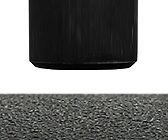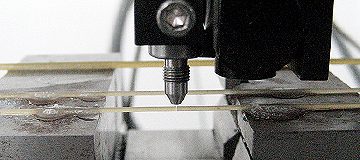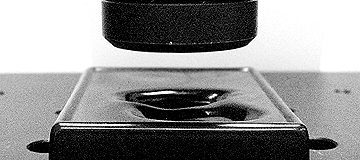
Petroleum Jelly Surface Measurement Using 3D Profilometry
Non-contact surface measurement has the advantage that eliminates the possibility of surface alteration of a given application (deformed, scratched or moved). This may be critical, for example, when measuring soft surfaces of films, gels and many others. Additionally, many of these soft surfaces will have transparent or absorptive surfaces leading to measurement error with some optical techniques. In this application the Nanovea ST400 Profilometer is used to measure the extremely soft and
transparent surface of lip balm made of a petroleum jelly.

Tooth Hardness Evaluation Using Nanoindentation
In this application, the Nanovea Mechanical Tester, in Nanoindentation mode, is used to study the hardness and elastic modulus of the dentin, decay and pulp of a tooth. The most critical aspect with Nanoidentation testing is securing the sample, here we took a sliced tooth and epoxy mounted leaving all three area of interest exposed for testing.
Here are examples of materials we tested this month:

Mechanical:
• Nanoindentation DMA of soft polymer
• Cermaic fracture toughness using Nanoindentation
• Nanoscratch of micro features
• Microindentation 3 Point Bend Test on pasta
• Microscratch of spray coatings

3D Non-Contact Profilometry:
• Finish of micro parts
• Texture of composite fabrics
• Roughness of various seals
• Topography of gel surfaces
• Dimensions of micro parts

Tribology:
• 24 hour Wear of various PVD coatings
Here are examples of materials we tested this month:

Mechanical:
• Nanoindentation of dental materials
• Nanoindentation compression of microbumps
• Nanoscratch of stent
• Nanoscratch of dental materials
• Microindentation multi cycle of various metals

3D Non-Contact Profilometry:
• Roughness of tablet press punch
• Step height of titanium oxide films
• Dimensions of metal chamfered edge

Tribology:
• Wear testing of enriched teflon
• Wear testing of nylon composite

MRS SPRING VISIT NANOVEA IN SAN FRANCISCO
SPRING MRS | April 1-5 San Francisco, CA
Starting with just four symposia in 1984, the MRS Spring Meeting and Exhibit has grown to over 50 symposia and over 5,000 attendees. Held annually in San Francisco’s Moscone West convention hall and the San Francisco Marriott Marquis, MRS Spring Meetings are essential events for discovering and presenting the very latest developments in materials research. www.mrs.org

3 Point Bend Test Using Microindentation
In this application, the Nanovea Mechanical Tester, in Microindentation mode, is used to measure the flexural strength (using 3 Point Bend) of various sized rod samples (pasta) to show a range of data. 2 different diameters were chosen to demonstrate both elastic and brittle characteristics. Using a flat tip indenter to apply a point load, we determine stiffness (Young’s Modulus) and identify the critical loads at which the sample will fracture.

Morphology Measurement of Heated Polymer
In this application the Nanovea ST400 Profilometer is used for morphology measurement of polymer before and after being subjected to heat deformation. The deformation could be characterized in several ways; here we will show the change in surface area, relative volume increase and decrease and flatness as defined by ISO 12781
Here are examples of materials we tested this month:

Mechanical:
• Nanoindentation of micropads
• Nanoindentation of various polymer coatings
• Nanoscratch of microwire
• Nanoscratch of paint coatings
• Microindentation fracture of micro ceramic parts
• Microscratch of thermal coatings

3D Non-Contact Profilometry:
• Finish of machined parts
• Texture of molded surfaces
• Roughness of nitinol wire
• Roughness of spray coatings
• CoPlanarity of microfluidic trays
• Dimension of micropatterns

Tribology:
• Wear testing of enriched teflon
• Wear testing of nylon composite
High Speed Nano Wear Testing Breakthrough
Feb 20, 2013 – Irvine, CA – Nanovea announced today the completion of a Nano Wear Testing System capable of speeds as high as 1400mm/sec. The unique length of stroke, up to 10mm, combined with a linear movement at a rate up to 70Hz, and possibly at higher frequencies, allows speeds never before available for Nano Wear Testing.
Wear testing instruments have existed for more than half a century. From the beginning, testing loads were typically higher than 1N and speeds were slow except in more recent fretting applications where displacement would be limited to 10’s of microns. Then Nanoindentation first appeared in the late 80’s with the capability to provide much lower loads. The first systems were, and still are in majority, based on a coil system with no feedback control loop. Feedback control loop is essential to provide superior load control when the position of contact is moved such as that required for scratch or wear testing. Nano Scratch Testing with piezo load cell combination appeared in the late 90’s. The first systems used cantilever technologies that gave sufficient speed to the feedback control during scratch and wear testing but the speed of displacement was, and still is limited to below 10mm/sec. For many applications the service life require a very high number of cycles to ensure that the device will hold up after years of use. At the slow speed available with cantilever technologies it could take more than 6 months to accomplish a single wear test. This is impractical and clearly slows down development and approval of new technology.
Nanovea is able to attain faster speeds and secure control of the loads during Nano Wear Testing by using a coil speaker system for quick and smooth displacement. Adding the use of the Nanovea Nano Module with a piezo actuator and an ultra-sensitive load cell creates a quick load control with vertical mounting to ensure superior response to speed.
“We were given the opportunity to really prove our team’s capability here with this project. We are very proud of this achievement. This new technology will speed up the introduction of new devices with increased service life to the customer market.” –CEO, Pierre Leroux
Here are examples of materials we tested this month:

Mechanical:
• Nanoindentation of wire cross sections
• Nanoindentation of Y2O3 thin films
• Nanoscratch of thin polymer films
• Nanoscratch of catheters
• Microindentation of oil-well cement

3D Non-Contact Profilometry:
• Roughness of catheters
• Finish of processed leather
• Topography of thin film particle contaminants
• Coplanarity of ball grid arrays
• Step height of microchannels
• Stribeck Curve evaluation of various lubrication









